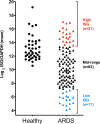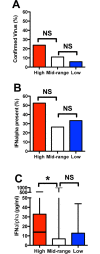Extremes of Interferon-Stimulated Gene Expression Associate with Worse Outcomes in the Acute Respiratory Distress Syndrome
- PMID: 27606687
- PMCID: PMC5015849
- DOI: 10.1371/journal.pone.0162490
Extremes of Interferon-Stimulated Gene Expression Associate with Worse Outcomes in the Acute Respiratory Distress Syndrome
Abstract
Acute Respiratory Distress Syndrome (ARDS) severity may be influenced by heterogeneity of neutrophil activation. Interferon-stimulated genes (ISG) are a broad gene family induced by Type I interferons, often as a response to viral infections, which evokes extensive immunomodulation. We tested the hypothesis that over- or under-expression of immunomodulatory ISG by neutrophils is associated with worse clinical outcomes in patients with ARDS. Genome-wide transcriptional profiles of circulating neutrophils isolated from patients with sepsis-induced ARDS (n = 31) and healthy controls (n = 19) were used to characterize ISG expression. Hierarchical clustering of expression identified 3 distinct subject groups with Low, Mid and High ISG expression. ISG accounting for the greatest variability in expression were identified (MX1, IFIT1, and ISG15) and used to analyze a prospective cohort at the Colorado ARDS Network site. One hundred twenty ARDS patients from four urban hospitals were enrolled within 72 hours of initiation of mechanical ventilation. Circulating neutrophils were isolated from patients and expression of ISG determined by PCR. Samples were stratified by standard deviation from the mean into High (n = 21), Mid, (n = 82) or Low (n = 17) ISG expression. Clinical outcomes were compared between patients with High or Low ISG expression to those with Mid-range expression. At enrollment, there were no differences in age, gender, co-existing medical conditions, or type of physiologic injury between cohorts. After adjusting for age, race, gender and BMI, patients with either High or Low ISG expression had significantly worse clinical outcomes than those in the Mid for number of 28-day ventilator- and ICU-free days (P = 0.0006 and 0.0004), as well as 90-day mortality and 90-day home with unassisted breathing (P = 0.02 and 0.004). These findings suggest extremes of ISG expression by circulating neutrophils from ARDS patients recovered early in the syndrome are associated with poorer clinical outcomes.
Conflict of interest statement
The authors have declared that no competing interests exist.
Figures




Similar articles
-
Differential type I interferon response and primary airway neutrophil extracellular trap release in children with acute respiratory distress syndrome.Sci Rep. 2020 Nov 4;10(1):19049. doi: 10.1038/s41598-020-76122-1. Sci Rep. 2020. PMID: 33149247 Free PMC article.
-
Bacteria-specific neutrophil dysfunction associated with interferon-stimulated gene expression in the acute respiratory distress syndrome.PLoS One. 2011;6(7):e21958. doi: 10.1371/journal.pone.0021958. Epub 2011 Jul 6. PLoS One. 2011. PMID: 21755013 Free PMC article.
-
Single cell transcriptomics identifies distinct profiles in pediatric acute respiratory distress syndrome.Nat Commun. 2023 Jun 30;14(1):3870. doi: 10.1038/s41467-023-39593-0. Nat Commun. 2023. PMID: 37391405 Free PMC article.
-
Neutrophil apoptosis: a marker of disease severity in sepsis and sepsis-induced acute respiratory distress syndrome.Crit Care. 2006;10(6):R155. doi: 10.1186/cc5090. Crit Care. 2006. PMID: 17092345 Free PMC article.
-
Bioinformatic identification of hub genes and key pathways in neutrophils of patients with acute respiratory distress syndrome.Medicine (Baltimore). 2020 Apr;99(15):e19820. doi: 10.1097/MD.0000000000019820. Medicine (Baltimore). 2020. PMID: 32282748 Free PMC article.
Cited by
-
Effect of bovine leukemia virus (BLV) infection on bovine mammary epithelial cells RNA-seq transcriptome profile.PLoS One. 2020 Jun 24;15(6):e0234939. doi: 10.1371/journal.pone.0234939. eCollection 2020. PLoS One. 2020. PMID: 32579585 Free PMC article.
-
Differential type I interferon response and primary airway neutrophil extracellular trap release in children with acute respiratory distress syndrome.Sci Rep. 2020 Nov 4;10(1):19049. doi: 10.1038/s41598-020-76122-1. Sci Rep. 2020. PMID: 33149247 Free PMC article.
-
Associations of DNA Methylation Mortality Risk Markers with Congenital Microcephaly from Zika Virus: A Study of Brazilian Children Less than 4 Years of Age.J Trop Pediatr. 2021 Jan 29;67(1):fmab020. doi: 10.1093/tropej/fmab020. J Trop Pediatr. 2021. PMID: 33822234 Free PMC article.
-
Increased Angiotensin-Converting Enzyme 2 and Loss of Alveolar Type II Cells in COVID-19-related Acute Respiratory Distress Syndrome.Am J Respir Crit Care Med. 2021 Nov 1;204(9):1024-1034. doi: 10.1164/rccm.202012-4461OC. Am J Respir Crit Care Med. 2021. PMID: 34449302 Free PMC article.
-
Lung Atelectasis Promotes Immune and Barrier Dysfunction as Revealed by Transcriptome Sequencing in Female Sheep.Anesthesiology. 2020 Nov 1;133(5):1060-1076. doi: 10.1097/ALN.0000000000003491. Anesthesiology. 2020. PMID: 32796202 Free PMC article.
References
-
- Iribarren C, Jacobs DR Jr., Sidney S, Gross MD, Eisner MD (2000) Cigarette smoking, alcohol consumption, and risk of ARDS: a 15-year cohort study in a managed care setting. Chest 117: 163–168. - PubMed
-
- Hudson L, Milberg J, Anardi D, Maunder R (1995) Clinical risk for development of the acute respiratory distress syndrome. Am J Respir Crit Care Med 151: 293–301. - PubMed
-
- Moss M, Bucher B, Moore FA, Moore EE, Parsons PE (1996) The role of chronic alcohol abuse in the development of acute respiratory distress syndrome in adults. Jama 275: 50–54. - PubMed
-
- Milberg JA, Davis DR, Steinberg KP, Hudson LD (1995) Improved survival of patients with acute respiratory distress syndrome (ARDS): 1983–1993. Jama 273: 306–309. - PubMed
MeSH terms
Substances
Grants and funding
LinkOut - more resources
Full Text Sources
Other Literature Sources
Medical
Research Materials
Miscellaneous

